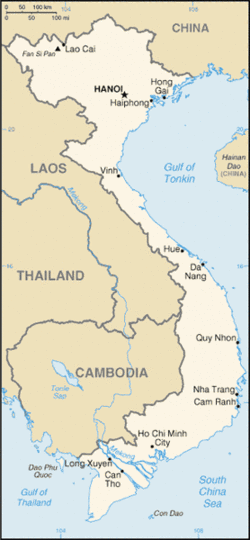Welcome to the Virtual Education Wiki ~ Open Education Wiki
Vietnam
Partners situated in Vietnam
There are no partners in Vietnam.
Vietnam in a nutshell
Copied from Wikipedia page about Vietnam.

Vietnam (Việt Namin Vietnamese), officially the Socialist Republic of Vietnam (Vietnamese: Cộng hòa xã hội chủ nghĩa Việt Nam), is the easternmost country on the Indochina Peninsula in Southeast Asia. It is bordered by China to the north, Laos to the northwest, Cambodia to the southwest, and the South China Sea to the east.
With a population of over 86 million, Vietnam is the 13th most populous country in the world.
The capital is Hanoi but the largest city is Ho Chi Minh City.
The people of Vietnam regained independence and broke away from China in AD 938 after their victory at the battle of Bạch Đằng River. Successive dynasties flourished along with geographic and political expansion deeper into Southeast Asia, until it was colonized by the French in the mid-19th century. Efforts to resist the French eventually led to their expulsion from the country in the mid-20th century, leaving a nation divided politically into two countries. Fighting between the two sides continued during the Vietnam War, ending with a North Vietnamese victory in 1975.
Emerging from this prolonged military engagement, the war-ravaged nation was politically isolated. The government’s centrally planned economic decisions hindered post-war reconstruction and its treatment of the losing side engendered more resentment than reconciliation. In 1986, it instituted economic and political reforms and began a path towards international reintegration. By 2000, it had established diplomatic relations with most nations. Its economic growth had been among the highest in the world in the past decade. These efforts culminated in Vietnam joining the World Trade Organization in 2007 and its successful bid to become a non-permanent member of the United Nations Security Council in 2008.
Vietnam is divided into 58 provinces (known in Vietnamese as tỉnh, from the Chinese 省, shěng). There are also 5 centrally-controlled municipalities existing at the same level as provinces (thành phố trực thuộc trung ương). The provinces are further subdivided into provincial municipalities (thành phố trực thuộc tỉnh), townships (thị xã) and counties (huyện), and then, subdivided into towns (thị trấn) or communes (xã). The centrally-controlled municipalities are subdivided into districts (quận) and counties, and then, subdivided into wards (phường).
Vietnam education policy
In Vietnam, education from age 6 to 11 is free and mandatory. Education above these ages is not free, therefore some poor families may find it hard to come up with the tuition for their children without some forms of public or private assistance. Regardless, school enrollment is among the highest in the world and the number of colleges and universities increased quite dramatically in recent years, from 178 in 2000 to 299 in 2005.
Vietnam education system
(Sourced from http://en.wikipedia.org/wiki/Vietnam)
Vietnam has an extensive state-controlled network of schools, colleges and universities but the number of privately-run and mixed public/private institutions is also growing.
General education in Vietnam is imparted in 5 categories: Kindergarten, elementary schools, middle schools, high schools, and college / university. Courses are taught mainly in Vietnamese. A large number of public schools have been organized across cities, towns and villages with the purpose of raising the national literacy rate which is already among the highest in the world.
There are a large number of specialist colleges, established to develop a diverse and skilled national workforce.
A large number of Vietnam's most acclaimed universities are based in Hanoi and Ho Chi Minh City.
Facing serious crises, Vietnam's education system is under a holistic reform launched by the government.
Higher education
Universities in Vietnam
Polytechnics in Vietnam
Higher education reform
The Bologna Process
Administration and finance
Quality assurance
Vietnam's HEIs in the information society
Towards the information society
Information society strategy
Virtual Campuses in HE
Interesting Virtual Campus Initiatives
Open Universities
The Ho Chi Minh City Open University (HCMCOU) is a 'semi-public' organisation and the country's first open university.
The Hanoi Open University (HOU) is a state university that offers open education courses.
Others
The Australian Royal Melbourne Institute of Technology RMIT has a campus in Vietnam.
Interesting Programmes
Re.ViCa Case-study
Lessons learnt
References
- Vietnamese government web site]
- Ministry of Education and Training
- Wikipedia page about Vietnam
- Wikipedia page about Vietnamese education
- News article Vietnam: Education in Vietnam - an Overview from 1945 – 9/2007, 2007, Vietnam Review
For OER policies and projects in Vietnam see Vietnam/OER